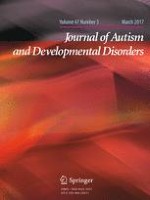12-01-2017 | Original Paper
Linguistic and Non-Linguistic Semantic Processing in Individuals with Autism Spectrum Disorders: An ERP Study
Gepubliceerd in: Journal of Autism and Developmental Disorders | Uitgave 3/2017
Log in om toegang te krijgenAbstract
Individuals with autism spectrum disorders (ASD) experience difficulties with language, particularly higher-level functions like semantic integration. Yet some studies indicate that semantic processing of non-linguistic stimuli is not impaired, suggesting a language-specific deficit in semantic processing. Using a semantic priming task, we compared event-related potentials (ERPs) in response to lexico-semantic processing (written words) and visuo-semantic processing (pictures) in adults with ASD and adults with typical development (TD). The ASD group showed successful lexico-semantic and visuo-semantic processing, indicated by similar N400 effects between groups for word and picture stimuli. However, differences in N400 latency and topography in word conditions suggested different lexico-semantic processing mechanisms: an expectancy-based strategy for the TD group but a controlled post-lexical integration strategy for the ASD group.
